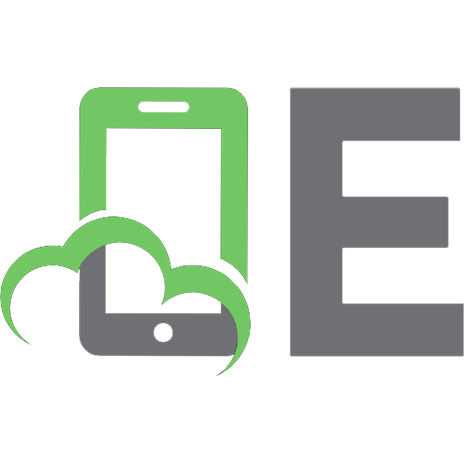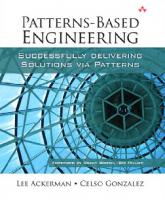Architectural Patterns and Techniques for Developing IoT Solutions 9781803245492
Apply modern architectural patterns and techniques to achieve scalable, resilient, and secure intelligent IoT solutions
135 21 16MB
English Pages 688 Year 2023
Table of contents :
Architectural Patterns and Techniques for Developing IoT Solutions
Foreword
Contributors
About the author
About the reviewers
Acknowledgments
Preface
Who this book is for
What this book covers
To get the most out of this book
Image credits
Conventions used
Get in touch
Share Your Thoughts
Download a free PDF copy of this book
Part 1: Understanding IoT Patterns
1
Introduction to IoT Patterns
An overview of IoT
IoT reference architecture
Unique requirements of IoT use cases
Recommended architecture principles and considerations
Summary
2
IoT Patterns for Field Devices
Device gateway
Pattern summary
Digital twin
Pattern summary
Device management
Pattern summary
Summary
3
IoT Patterns for the Central Server
AI/ML integration
Pattern summary
The rule engine
Pattern summary
File upload
Pattern summary
Enterprise system integration
Pattern summary
Summary
Part 2: IoT Patterns in Action
4
Pattern Implementation in the Consumer Domain
Use case – deploying home automation
A detailed description of the use case
Use case – a smart egg boiler
A detailed description of the use case
Realizing the use case
Summary
5
Pattern Implementation in the Smart City Domain
A smart speaker for modernizing education
Monitoring the condition of perishable goods
Driver behavior monitoring
Automatic replenishment of consumables and raw materials
Additional use cases
Summary
6
Pattern Implementation in the Retail Domain
An overview of the retail domain
Using real-time IoT data
Implementing sensors and actuators in retail stores
Use case – real-time tracking in retail outlets
Privacy concerns
Leveraging IoT patterns
Summary
7
Pattern Implementation in the Manufacturing Domain
An overview of smart manufacturing
Key terms/definitions
Exploring the evolution of the manufacturing domain
The benefits of smart manufacturing
Challenges in transitioning from traditional to smart manufacturing
Automatic inspection of finished goods or parts
Summary
8
Pattern Implementation in the Agriculture Domain
An overview of smart agriculture
Key terms/definitions
Factors influencing greater adoption of smart agriculture technologies
Use cases of IoT in smart agriculture
Resolving agricultural challenges with a land consolidation platform
Mitigating agricultural challenges
Summary
Part 3: Implementation Considerations
9
Sensor and Actuator Selection Guidelines
Key terms/definitions
Usage scenarios of sensors
Operation and usage scenarios of actuators
Key characteristics of actuator types
Use cases for actuators
Use case – connected coffee vending machine
Factors to be considered while selecting a sensor or actuator
Introducing wireless sensor and actuator networks
Summary
10
Analytics in the IoT Context
Key terms/definitions
Implementing IoT analytics
Stages of implementing IoT analytics
Integrating ML capabilities into IoT analytics
Understanding the importance of data quality
Relevance of edge analytics
Considerations for IoT visualization
Summary
11
Security in the IoT Context
Key terms/definitions
Comparing IoT security and IT security
Challenges in securing IoT solutions
IoT security vulnerabilities
Major IoT security breaches
Mitigating IoT security vulnerabilities
Domain-specific security considerations
Applicable security standards and best practices
Summary
Part 4: Extending IoT Solutions
12
Exploring Synergies with Emerging Technologies
Blockchain
Benefits of combining IoT and blockchain
Possible use cases
Generative AI
Benefits of combining IoT and generative AI
Possible use cases
Large language models
Benefits of combining IoT and LLM
Possible use cases
AI/ML
Benefits of combining IoT and AI/ML
Possible use cases
Immersive technologies
Benefits of combining IoT with immersive technologies
Possible use cases
3D and 4D printing
Benefits of combining IoT with 3D and 4D printing
Possible use cases
5G and 6G technology
Benefits of combining IoT with 5G and 6G technologies
Possible use cases
Drones
Possible use cases
Social media
Benefits of combining IoT and social media
Possible use cases
Cloud computing
Benefits of combining IoT and cloud computing
Possible use cases
Energy harvesting
Benefits of combining IoT and energy harvesting
Possible use cases
Quantum computing
Benefits of combining IoT and quantum computing
Possible use cases
Web 3.0
Benefits of combining IoT and Web 3.0
Possible use cases
Edge computing
Benefits of combining IoT and edge computing
Possible use cases
Summary
13
Epilogue
Project implementation considerations
Lessons learned from IoT projects
NFR considerations
Battery or power optimization
Cost optimization
IoT connectivity protocols
Summary
Index
Why subscribe?
Other Books You May Enjoy
Packt is searching for authors like you
Share Your Thoughts
Download a free PDF copy of this book
Architectural Patterns and Techniques for Developing IoT Solutions
Foreword
Contributors
About the author
About the reviewers
Acknowledgments
Preface
Who this book is for
What this book covers
To get the most out of this book
Image credits
Conventions used
Get in touch
Share Your Thoughts
Download a free PDF copy of this book
Part 1: Understanding IoT Patterns
1
Introduction to IoT Patterns
An overview of IoT
IoT reference architecture
Unique requirements of IoT use cases
Recommended architecture principles and considerations
Summary
2
IoT Patterns for Field Devices
Device gateway
Pattern summary
Digital twin
Pattern summary
Device management
Pattern summary
Summary
3
IoT Patterns for the Central Server
AI/ML integration
Pattern summary
The rule engine
Pattern summary
File upload
Pattern summary
Enterprise system integration
Pattern summary
Summary
Part 2: IoT Patterns in Action
4
Pattern Implementation in the Consumer Domain
Use case – deploying home automation
A detailed description of the use case
Use case – a smart egg boiler
A detailed description of the use case
Realizing the use case
Summary
5
Pattern Implementation in the Smart City Domain
A smart speaker for modernizing education
Monitoring the condition of perishable goods
Driver behavior monitoring
Automatic replenishment of consumables and raw materials
Additional use cases
Summary
6
Pattern Implementation in the Retail Domain
An overview of the retail domain
Using real-time IoT data
Implementing sensors and actuators in retail stores
Use case – real-time tracking in retail outlets
Privacy concerns
Leveraging IoT patterns
Summary
7
Pattern Implementation in the Manufacturing Domain
An overview of smart manufacturing
Key terms/definitions
Exploring the evolution of the manufacturing domain
The benefits of smart manufacturing
Challenges in transitioning from traditional to smart manufacturing
Automatic inspection of finished goods or parts
Summary
8
Pattern Implementation in the Agriculture Domain
An overview of smart agriculture
Key terms/definitions
Factors influencing greater adoption of smart agriculture technologies
Use cases of IoT in smart agriculture
Resolving agricultural challenges with a land consolidation platform
Mitigating agricultural challenges
Summary
Part 3: Implementation Considerations
9
Sensor and Actuator Selection Guidelines
Key terms/definitions
Usage scenarios of sensors
Operation and usage scenarios of actuators
Key characteristics of actuator types
Use cases for actuators
Use case – connected coffee vending machine
Factors to be considered while selecting a sensor or actuator
Introducing wireless sensor and actuator networks
Summary
10
Analytics in the IoT Context
Key terms/definitions
Implementing IoT analytics
Stages of implementing IoT analytics
Integrating ML capabilities into IoT analytics
Understanding the importance of data quality
Relevance of edge analytics
Considerations for IoT visualization
Summary
11
Security in the IoT Context
Key terms/definitions
Comparing IoT security and IT security
Challenges in securing IoT solutions
IoT security vulnerabilities
Major IoT security breaches
Mitigating IoT security vulnerabilities
Domain-specific security considerations
Applicable security standards and best practices
Summary
Part 4: Extending IoT Solutions
12
Exploring Synergies with Emerging Technologies
Blockchain
Benefits of combining IoT and blockchain
Possible use cases
Generative AI
Benefits of combining IoT and generative AI
Possible use cases
Large language models
Benefits of combining IoT and LLM
Possible use cases
AI/ML
Benefits of combining IoT and AI/ML
Possible use cases
Immersive technologies
Benefits of combining IoT with immersive technologies
Possible use cases
3D and 4D printing
Benefits of combining IoT with 3D and 4D printing
Possible use cases
5G and 6G technology
Benefits of combining IoT with 5G and 6G technologies
Possible use cases
Drones
Possible use cases
Social media
Benefits of combining IoT and social media
Possible use cases
Cloud computing
Benefits of combining IoT and cloud computing
Possible use cases
Energy harvesting
Benefits of combining IoT and energy harvesting
Possible use cases
Quantum computing
Benefits of combining IoT and quantum computing
Possible use cases
Web 3.0
Benefits of combining IoT and Web 3.0
Possible use cases
Edge computing
Benefits of combining IoT and edge computing
Possible use cases
Summary
13
Epilogue
Project implementation considerations
Lessons learned from IoT projects
NFR considerations
Battery or power optimization
Cost optimization
IoT connectivity protocols
Summary
Index
Why subscribe?
Other Books You May Enjoy
Packt is searching for authors like you
Share Your Thoughts
Download a free PDF copy of this book

![Architectural Patterns and Techniques for Developing IoT Solutions: Build IoT applications using digital twins, gateways, rule engines [Team-IRA]
1803245492, 9781803245492](https://ebin.pub/img/200x200/architectural-patterns-and-techniques-for-developing-iot-solutions-build-iot-applications-using-digital-twins-gateways-rule-engines-team-ira-1803245492-9781803245492.jpg)






![IoT Technical Challenges and Solutions [1 ed.]
9781630814373, 9781630811112](https://ebin.pub/img/200x200/iot-technical-challenges-and-solutions-1nbsped-9781630814373-9781630811112.jpg)

